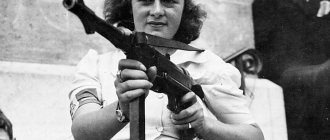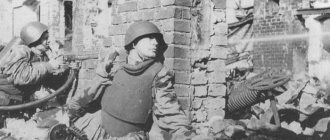To more accurately explain how Operation Citadel took place, it is necessary to introduce some military concepts.
The front line is understood as a straight line along the entire length of which troops are located. It should not be interrupted or take other forms, since the effectiveness of defense depends on this.
However, during combat operations on the front line, for various reasons, so-called “protrusions” and “gaps” are formed. As a rule, the warring parties try to eliminate them, that is, to level the front line. When this fails, a strategic and tactical game begins around these ledges. This is what happened with the Kursk salient in the summer of 1943.
The ledge was formed during the Ostrog-Rossoshan operation in the winter of 1943. The 60th Army of General Chernyakhovsky, as part of the Voronezh Front, broke through the enemy’s defenses on January 25, liberated Voronezh and advanced 150 kilometers without encountering resistance. There were 25 kilometers left to Kursk, and the offensive potential of the army was not exhausted. Our units rushed to the Kursk area and on February 8 the city was liberated. After this, the troops switched to positional defense.
This is how the Kursk ledge was formed. Subsequently it received the name “Kursk Bulge”.
Battle of Kursk
Preparatory stage
The period from December 1942 to February 1943 on the Eastern Front was generally unsuccessful for the German army. In March, the Germans managed to regain control of Kharkov, and the front line between Orel and Belgorod began to resemble an arc.
Rice. 1. Operation Citadel.
Both cities were controlled by the Germans, but the Red Army was entrenched in Kursa, which is why the arc in the history of the Second World War is called “Kursk”. The start date for the development of Operation Citadel should be considered March 13, when an order signed by Hitler was issued with the goals of military operations on the Soviet-German front in the spring-summer of 1943. Two army groups were to take part in the offensive on the Kursk salient - “South” and “Center”.
It was planned to transfer new types of weapons to the advancing units of the German army - Tiger and Panther tanks, as well as Ferdinand self-propelled guns.
In March-April there was an operational pause at the front, including due to the spring thaw. The Soviet command also did not waste time, concentrating fresh forces at the front and conducting reconnaissance. As a result, information about the preparation of Operation Citadel also came from the British codebreaker John Cairncross.
The final version of the offensive operation was approved on April 15, 1943. The first date of the offensive was May 3, but already on May 2, the Germans began to suspect that the Soviet command had figured out the offensive plan, so the dates were postponed first to June 12, and then to July 5.
Rice. 2. Battle of Kursk.
The Citadel from the inside - we conquer and win the favor of significant people
In the depths of every person’s psyche there often lies an impregnable citadel with its own fortification system, reliable guards and faithful security. To influence and influence a person it is often necessary to penetrate his stronghold. Any attempt at an assault is usually doomed to failure. Until you know your opponent's system of values, views and judgments, effective communication will be a difficult and sometimes impossible task for you. To penetrate the fortress unnoticed, you need to know its detailed plan. It's even better to have keys to secret passages that allow you to enter the fortress undetected.
Each person with his own inner world, psychological characteristics and perception of reality reveals his own microworld. In the depths of his psyche there often lies an impregnable citadel with its own fortification system, reliable guards and faithful security. To influence and influence a person it is often necessary to penetrate his stronghold.
Any attempt at an assault is usually doomed to failure. Standing on the ruins of a citadel destroyed by your facts and arguments, you will not be able to achieve effective influence and influence. The resentment of defeat only gives rise to the desire for revenge and restoration of the status quo at any cost at the first opportunity.
Until you know your opponent's system of values, views and judgments, effective communication will be a difficult and sometimes impossible task for you. One of the conditions for successful communication is that the communicator must be more creative than his interlocutor.
In order to penetrate the fortress unnoticed, you need to know its detailed plan, indicating patrol routes and internal security posts. It is also useful to know at least one gate that is open to the communicator. It's even better to have keys to secret passages that allow you to enter the fortress undetected. In most cases, the plans for fortresses of different people are the same, regardless of personality type, gender and race.
Citadel Plan: Self-Assessment
The citadel is the inner “I” of a person, his Ego, self-esteem, inner core. The strength and height of the walls of the citadel depend on two interrelated qualities of a particular person. They are determined by the customs of his environment and previous upbringing. These qualities are pride and self-esteem.
Self-esteem is the measure by which a person measures himself. The best option is when self-esteem corresponds to a person’s real achievements and successes. However, more often self-esteem can be high or low, as well as underestimated or overestimated. The discrepancy between self-esteem and real achievements and successes represents various variants of overestimated or underestimated self-esteem.
The more successful and fulfilled a person is in life, the higher his self-esteem and the easier it is to establish stable and productive contact with him. However, it is much more difficult to influence and influence such a person than an opponent with low or low (inflated) self-esteem.
A person with low self-esteem often perceives everything around him as a threat. Often a critical look, remark or rude word is enough - and for him what is happening seems like a disaster. Such people are able to discern an insult in the most innocent expression, hint or remark. Any attempt to gain the upper hand in an argument or controversy can usually lower their self-esteem even further. In turn, this complicates attempts to further communicate with them.
Self-esteem is revealed by appearance, demeanor, and also by the manner of communication with others.
The most important quality of self-esteem: people perceive you based on your self-esteem or the self-esteem of the role in which you speak to a specific target audience. If you show yourself as a waste of space, you allow others to either ignore you or humiliate you.
Any attempts to make fun, tease, or make sarcastic remarks about the interlocutor are aimed directly at his self-esteem. Therefore they must be avoided. Even an innocent joke made to an opponent with low or low self-esteem can interrupt and even completely stop developing communication. Eliminate sarcasm and ridicule from your communication, especially at first.
Citadel Plan: Self-Love
Inherent and interdependent on self-esteem is another quality of any person - self-love. How does it manifest itself? As a rule, every person wants to feel his own importance and wants to be taken into account by those around him. The size of this environment directly depends on self-esteem: from recognition of importance in the family to recognition as the head of state.
More on the blog: Detecting and eliminating irrational hidden attitudes
What are the properties of self-love?
- Another person's ego can be effectively managed.
- People act or fail to act largely to satisfy their ego.
- Self-love loves and ignores flattery. The more subtle, unnoticeable and veiled this flattery is, the more readily it is accepted by a person’s pride.
- Self-love is aggressive by nature: there is nothing more dangerous than wounded pride. Anyone opposing our thoughts, ideas or statements is perceived by our ego (and by us) as a direct and immediate threat. It is possible to convince your opponent only when his pride is not subjected to pressure and threats.
- Only by satisfying the needs of his pride is a person able to escape from his own worries and see your problems.
Thus, the ego is the citadel, and self-esteem and pride determine the height and thickness of its fortress walls. Now, knowing the plan of the opponent's citadel, you can understand why you should not storm this fortress. Any open opposition to the thoughts and ideas of an opponent is perceived by him as a threat to his pride and self-esteem. Any attempt to crush your interlocutor with a direct ramming blow of impeccable, ponderous and irrefutable arguments does not achieve its goal. After all, it is not his reasons and arguments that come under attack, but he himself directly, with all his unique nature, subtle and vulnerable soul, aesthetic needs, etc. The situation is aggravated when a person suffers such a defeat in the presence of others.
Secrets of protecting the citadel
The fortress is not empty; it has a garrison, patrols and guards. It is impossible to achieve effective communication without affecting the guards and garrison of the opponent's stronghold.
The garrison is unchanged for any person. It consists of two types of experienced defenders: consciousness and unconscious (subconscious) . They are the ones who vigilantly ensure that strangers (in the form of other people’s ideas and thoughts) cannot get into the fortress and do not damage the individual’s pride and self-esteem.
The defenders of the fortress differ from each other. Consciousness turns more to logic and arguments. It is capable of giving way under the pressure of facts and allowing someone else’s idea to penetrate the fortress.
Logic and evidence are alien to the subconscious. It appeals to external and internal images. It notices the opponent’s nonverbal signals indicating his sincerity or insincerity. The categories of the unconscious “like” - “dislike” transform into “trust” - “don’t trust”, and then into “us” - “stranger”.
When the consciousness of the interlocutor, under the weight of arguments, is ready to let the thoughts and ideas of a stranger into the fortress, the unconscious stands in their way like an “iron curtain.” For him, logical argumentation has no meaning or meaning.
Consciousness and unconsciousness complement each other, acting as one team. When an opponent tries to forcefully introduce his ideas into the interlocutor (for example, ridiculing his position), the consciousness strengthens the defense, and the unconscious tightly closes the consciousness to the perception of the opponent.
Having a plan of the fortress and knowing its security, you can derive the rule of four “don’ts” . So, in the process of communication:
- You cannot lower your interlocutor’s self-esteem;
- you cannot attack the self-esteem of your interlocutor;
- the subconscious should not be underestimated, for which logic and evidence have no practical meaning;
- You cannot forcefully attack the consciousness of your interlocutor, ridiculing his ideas and thoughts.
Knowledge of the citadel and its garrison guarantees the communicator's penetration into the fortress. Next, in order to carry out a control or corrective influence, it is necessary to change the opponent’s system of views and coordinates.
Secrets of infiltration
We have already become familiar with the rules “you can’t have four.” But what is possible?
- you should increase the self-esteem of your interlocutor in every possible way;
- one should fully satisfy the self-esteem of the interlocutor, even lowering one’s own self-esteem, becoming at least equal to the interlocutor, and in some cases lower than the interlocutor;
- you should work closely with the subconscious of your interlocutor, taking into account that resorting to logic and arguments is useless here;
- When promoting your own thoughts and ideas, you must strive to place your interlocutor within the framework of a partner, not an opponent, indirectly changing his own ideas and thoughts.
More on the blog: Epidemic of panic: how to stop being afraid of coronavirus
How to apply this in practice? First, remember the “mirror effect.” In the mirror, your reflection performs the same actions as you. The same principle applies to influence: you can control the actions of your interlocutor with the help of your own actions and attitude towards him. Your attitude towards your opponent is returned to you by the reflected interlocutor - like a mirror image, unless the interlocutor has a reprehensible attitude towards you.
By acting with hostility or expressing hostility towards your opponent, you are guaranteed to receive his hostility reflected back. Raise your voice during a conversation, and your interlocutor will respond in kind. Act calmly and unemotionally and you will stop his anger.
Next, how to increase the self-esteem of your interlocutor?
- First, make a good impression on your interlocutor. His subconscious will give you extra points for this. Clothes, shoes, accessories, posture, demeanor, language of communication - these are the components of the first (and often indelible) impression on your interlocutor. Use them.
- Secondly, let the other person feel and show him your importance to you. This will not only increase his personal self-esteem, but will also partially satisfy his pride.
From the first seconds of communication, discarding logic and argumentation, the subconscious of the interlocutor begins to probe the opponent: “one of our own” or “someone else’s” and whether he can be trusted. Elements of subconscious perception - any verbal and non-verbal signals coming from the opponent, and their compliance with two criteria:
- Compliance with the internal standards of the interlocutor himself.
- Correspondence of incoming signals to the role represented (played) by the interlocutor.
As a rule, it is the subconscious that is the first to identify the discrepancy between the imagined image of the interlocutor and the signals he sends. This way the subconscious increases the anxiety and mistrust of the interlocutor.
How can you consolidate your first favorable impression?
The qualities of an effective communicator are tolerance and listening skills. Do you enjoy communicating with a person who always has an answer to any question (even before it is asked)? Do you like a person who interrupts you without listening to the end?
But you attach great importance to the words of your interlocutor and listen to him carefully, trying not to miss a single word. This of course proves to him that you are a very sensible and intelligent person. After all, a stupid interlocutor would not be able to realize how valuable and important the ideas expressed are. Therefore, it is a pleasure to do business with you.
Managing a conversation also involves the ability to formulate and ask questions correctly. If you want to achieve a positive outcome in negotiations, do not ask your interlocutor questions that imply negative answers. An effective communicator will never ask questions, answer questions, or conduct a conversation as if he expects resistance.
Another effective way to consolidate and make a favorable impression is not to try to actively influence the interlocutor at the first contact . This is also recorded by the subconscious. Instead, let your interlocutor understand that he himself made an extremely good and favorable impression on you.
The first way to increase the importance of your interlocutor is to tune yourself to the fact that your interlocutor is of high importance to you. Otherwise why would you bother with it and try to exert influence or influence. A similar setting is transmitted to your interlocutor - after all, all verbal and non-verbal signals emanating from you will emphasize his importance.
You will receive a much higher rating from your interlocutor if you turn the conversation not on yourself, but on him. He will have a better opinion of you and will consider you smart, flexible, friendly and an intelligent conversationalist.
Using these principles and techniques, you overcome your opponent’s self-esteem and pride, that is, the walls of his inner citadel.
So, you are inside the fortress - the infiltration was successful.
Author: Genrich Ernstovich Lemke , business consultant on business risk research, full member of the Community of Competitive Intelligence Practitioners (SPCP).
Source
Read us in a convenient Telegram | Facebook | Instagram | Tags
The July offensive and its results
Field Marshals Kluge and Manstein assumed command of Army Groups Center and South. By the beginning of July, the size of the German group was about 800-900 thousand soldiers, supported by 2,700 tanks and self-propelled guns, 10 thousand guns and 2 thousand aircraft. The Red Army opposing them was divided into three fronts - Central, Voronezh, Stepnoy. They were superior to the Germans in all respects, but least so in aircraft.
The German offensive began on July 5 from Orel and Belgorod in the direction of Kursk. The most serious battles broke out near the village of Ponyri on the northern front of the Kursk Bulge and at Prokhorovka station on the southern front.
The German offensive was stopped by July 18-23. Next, the Red Army went on the offensive and carried out two offensive operations - “Rumyantsev” and “Kutuzov”, which resulted in the liberation of Belgorod and Orel. The offensive initiative finally passed to the Red Army.
Rice. 3. Battle of Kursk.











